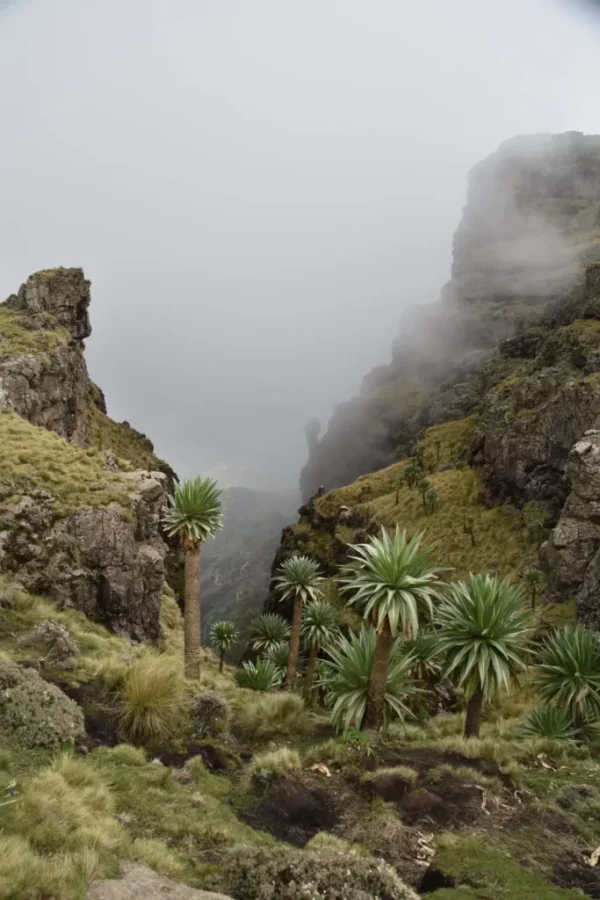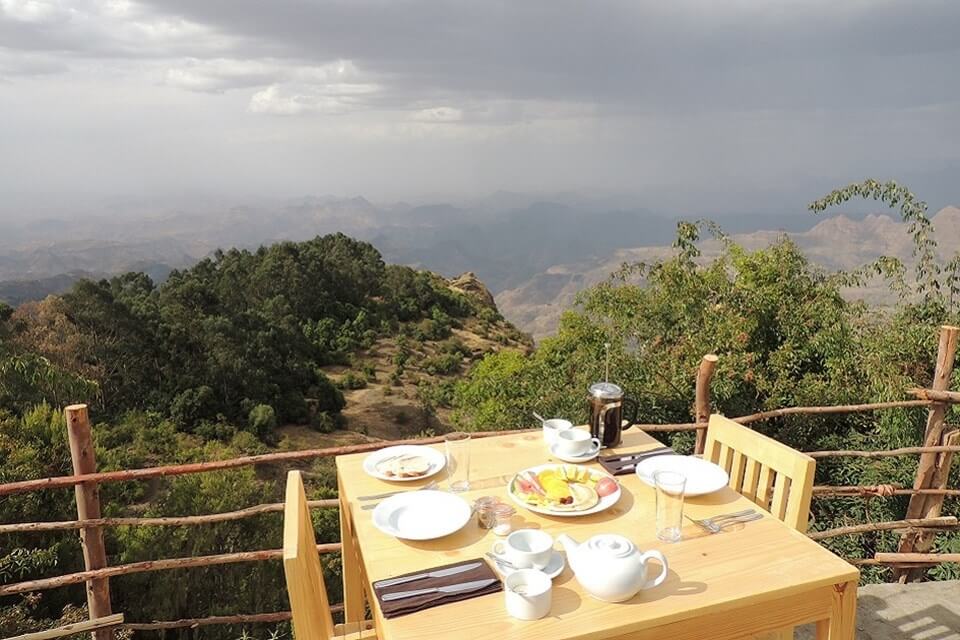
What are the must-see places in Ethiopia?
With all of its buzz and urban energy, Addis Abeba has been undergoing a transformation, with an increasing number of parks sprouting up all over the city. Here are some of the best options for green space in town.
Church of Saint George, Lalibela
The Church of Saint George, known locally as Bete Giyorgis, was built by King Gebre Mesqel Lalibela of the Zagwe dynasty as the last of eleven rock-hewn churches to be built in Lalibela and remains a site of enormous cultural and religious significance.
According to popular mythology, the king had an apparition in which one of God’s angels revealed plans for a structure capable of bringing heaven down to Earth.
The king commissioned the project to build the Church of Saint George after being inspired by his vision. The mythology goes on to say that when it was finished, the same angels came to the site and blessed everyone who was there.
The hoofprints of the white stallion that St George rode on the day the church was finished are said to be imprinted in the rocks surrounding the church.
The church’s entrance is reached through a network of sunken trenches and tunnels that connect to a number of adjoining churches, sanctuaries, and baptismal courtyards.
Among the labyrinth of sanctuaries are a number of tombs that house former monks and priests who dedicated their lives to the church and its survival.
The church also contains a number of hidden treasures that are only accessible to a few high-ranking priests. Among these treasures is a wooden box that appears to have been carved by the king himself.

The only material used in its construction was the volcanic rock found on site, which was built on a cruciform plan.
The church has three west-facing doorways as well as a number of windows. The motifs on each layer of the building lead to the roof, which is covered in intersecting crosses that lie within a larger Greek cross.
The church’s walls reach a height of 30 meters, and over 3,400 meters cubed of rock was excavated from the site to shape the monolith’s exterior. A further 450 metres cubed was removed from here to accommodate the opulent interior.
When you walk in, you’ll be struck by the brightly colored frescoes depicting St George’s trials and tribulations, which are surrounded by interweaving blue, gold, and red patterns.
These paintings, which are spread across the room, lead visitors down a spiritual rabbit hole full of painted prophetic predictions based on King Lalibela’s dream all those years ago.
The Church of St George, now officially recognized as the world’s eighth wonder, is a mesmerizing display of faith and represents the beating heart of spiritual Ethiopia.

Wisps of smoke appear above the trail, indicating that a rest is on the way. Each stop is a welcome reprieve and opportunity to refuel.
Local merchants who live in the park sell food and drink along the path; these mountains are their home, so don’t expect to see them panting.
The views are breathtaking all around, and the ascent climb is gentle enough to allow you to enjoy the scenery and converse with your guides rather than focusing solely on the path ahead.
There are several ways to descend Ras Dashen.
If your legs allow it, you can return the way you came to take in more of the stunning Simien Mountains scenery.
Weary travelers can take advantage of a fleet of minibuses and cars parked just a short walk from the peak, which will transport them down to Dilibza. A high-altitude road (4,200 meters) intersects the park here and leads visitors back down to Debark.
Ras Dashen
Ras Dashen, also known as Ras Dejen, is the Simien Mountains National Park’s crown jewel.
This Goliath is not easy to conquer, but local guides and scouts can help you navigate the most accessible trails.
The entire Ras Dashen hike can take up to 12 hours, with 7 hours going up and 5 hours going down.
Surprisingly, for the majority of the hike, the trail follows relatively even terrain. There are some steeper gradients, but the difficulty comes from the length and increasing altitude.
Ras Dashen is located on the park’s eastern escarpment, away from the main ridge that attracts the majority of visitors.
To reach Ras Dashen, you must first camp in the mountains, most commonly at the Ambiko base camp (although there are more rugged routes for those who really want to get out into the sticks).
Ras Dashen cannot be hiked while staying at a lodge because the only two lodges, Limalimo Lodge and Simien Lodge, are on the other side of the park.
Most visitors who attempt Ras Dashen spend two or three nights camping on the primary escarpment to acclimate and see all of the best viewpoints before proceeding to Ras Dashen.
Most visitors to the Simien Mountains stick to the main escarpment and spend 2-3 nights in the mountains. If you want to climb Ras Dashen, you’ll need at least two extra days, and possibly more depending on your fitness and the route you take.
Limalimo Lodge
The views, aesthetic, and service at this lodge make it the ideal starting or ending point for any Simien trek. If you want to explore the park without sacrificing comfort, you can take sorties from here.
- Limalimo Lodge is consistently voted one of Ethiopia’s best hotels – a simple yet luxurious place to stay that exemplifies responsible tourism without skimping on the essentials.
- The hotel is perched on an escarpment with panoramic views for miles.
- It’s the ideal location for exploring the Simien Mountains and seeing the incredible wildlife that lives there. Day trips into the mountains are available, or you can use the lodge’s comfort to prepare for or recover from a night or two under the stars in the campgrounds.
- The hotel is deeply committed to the environment and the local community, and it provides understated luxury in a straightforward, sensitive, and thoughtful manner.
Limalimo is a 10-minute drive from Debark (the Simien Mountains’ entrance town) and is perched on the edge of an escarpment with spectacular views of the Simien Mountains.
The hotel was designed with the environment in mind, using rammed earth and thatch to blend into the landscape. The rooms are simple, with a mix of Ethiopian design and modern finishes.
If you want to spend time outside with a view of the extraordinary stars (the Simiens are renowned for their excellent star-gazing), visit the fire pit, or guests can participate in one of the regular yoga sessions or receive a massage!
.
There are 12 rooms, all en-suite with private balconies that are found throughout the 10-hectare site with a number of new rooms being built.
The rooms are simple, yet luxurious with comfortable beds and minimal fuss. Each room features floor-to-ceiling windows with fantastic views – all of the rooms have great views, with none being much better than others.
Limalimo usually offers a full-board rate, get in touch for more info.

Set out on full or half-day hikes with a private guide. If you’re feeling particularly daring, you can camp out under the stars in one of the area’s campsites, aided by a team of guides, cooks, and porters.
Limalimo is a fantastic base from which to explore the mountains, whether you’re a keen birder or want to see the Gelada monkeys or some of the park’s rarer animals.
At Brilliant, we also enjoy the opportunity to visit the villages, particularly the nearby Limalimo village, and participate in a coffee ceremony, or simply relax around the lodge here on Africa’s roof.
Limalimo Lodge, which opened in 2015 and has only 12 rooms, has quickly become one of the best hotels in Ethiopia, and is frequently booked out months in advance.
Fortunately for you, they’re expanding and their service is constantly improving as they host more and more satisfied visitors.
While Ethiopia frequently struggles to provide ‘world-class’ accommodations, Limalimo is one of the few that lives up to its name.

There is a restaurant and bar, as well as a terrace with views of the Simiens.
Local ingredients are used in the meals, which are sourced from local suppliers whenever possible. The food is excellent, with a good mix of local and Western dishes available if required.
If you want to go all out, Champagne breakfasts might just make someone’s day.
.
Limalimo is an excellent example of the best in tourism.
Conceived by local guides, built by Simien park residents, and incorporating many of the best architectural elements, it manages to be one of Ethiopia’s best hotels while also being sensitive to the delicate local environment and employing many locals.
The lodge was built with local materials, the energy comes from renewable sources, and the wastewater is reused.

Ambassador Park
One of the oldest parks in the city, Ambassador Park is a popular destination for families, friends and couples. The beautiful grounds are filled with a variety of flowers set along winding walkways that truly ease the spirit. There’s also an excellent restaurant where visitors can grab a beer after gazing at the gorgeous scenery.
Friendship Park
Friendship Park, one of the city’s larger green spaces, has many amenities that make it worth a visit, including a beautiful lake filled with fish, waterlilies, and even the occasional duck. It’s also a great place to go for an early morning run, thanks to paved roads that are ideal for running and long staircases for some intense cardio. By appointment, early morning yoga sessions are also available in the park. After all that exercise, reward yourself at one of Friendship Park’s two restaurants, followed by an indulgent treat at the ice cream store or simply stopping by the juice bar to keep the healthy vibes flowing.


Peacock Park
This hidden treasure in the Bole area is a welcome break from everyday life and one of Addis’ lesser-known parks (also known as Central Park). Look for the stone structures that adorn the exterior walls and run alongside the adjacent riverway, giving the park an otherworldly feel as you wander. The inventive construction, lush grounds, and diverse flora make this a great park for anyone looking for a hidden gem.
Unity Park
Found in the compound of the National Palace of Ethiopia, this one-of-a-kind park is home to all kinds of wildlife, more than a few of which can be found in the zoo, aquarium and aviary. There are pavilions for each region of Ethiopia, giving an introduction to the diverse culture of the country, and if you want to keep up the historical learning afterwards, parts of the palace are available to view on a guided tour.


Golla Park
Filled with ancient trees, this well-maintained park is also the home of the St George Gallery, which hosts contemporary visual art exhibitions. The park is a scenic and cosy place to spend an afternoon, whether you’re reading a book, enjoying a cup of coffee or just sitting back and relaxing.
Travel to Ethiopia
Ethiopia is a rugged, landlocked country in the Horn of Africa divided by the Great Rift Valley. It's a place of ancient culture, with archaeological finds dating back more than 3 million years.
History of Ethiopia
Ethiopia is bounded to the north by Eritrea, to the northeast by Djibouti, to the east by Somalia, to the south by Kenya, and to the west by South Sudan and Sudan.
People Of Ethiopia
Ethiopians are ethnically diverse, with the most significant differences based on linguistic classification. Ethiopia is a linguistic mosaic of about 100 languages divided into four groups.
Terminal 2: Etiopian Airlines Star Alliance Gold Lounge
- Opening hours: first to last departure of the day
- Services: premium food and snacks, WiFi, television, newspapers and magazines

